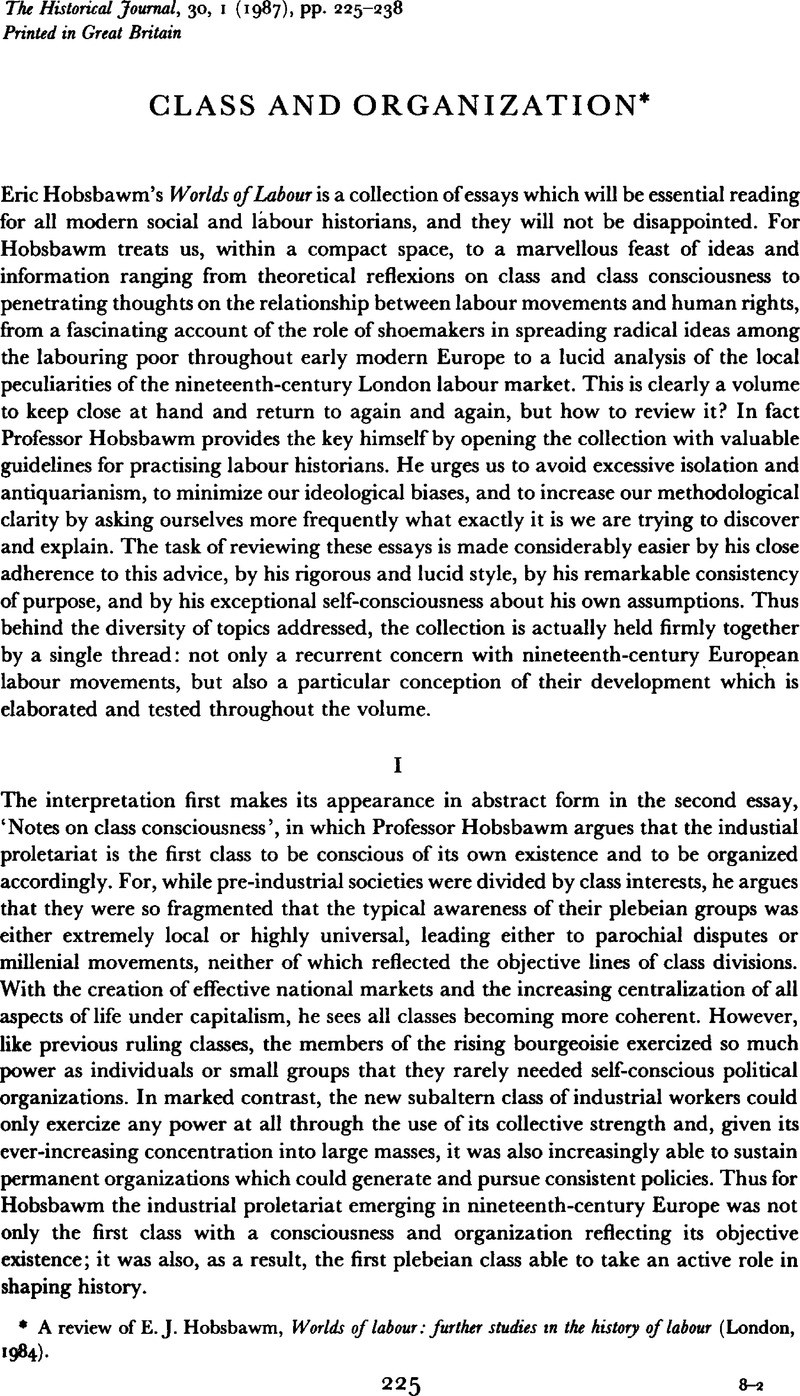Article contents
Class and Organization*
Published online by Cambridge University Press: 11 February 2009
Abstract

- Type
- Review Articles
- Information
- Copyright
- Copyright © Cambridge University Press 1987
References
1 For the centrality of the debate over the transition to capitalism for British Marxists see Hilton, R (ed ), The transition from feudalism to capitalism (London, 1976)Google Scholar which contains a contribution by Hobsbawm, and for an interesting review of his work on European history see Jones, G Stedman, ‘Society and politics at the beginning of the world economy’ Cambridge Journal of Economics 1 (1977), 77–92CrossRefGoogle Scholar
2 See also Hobsbawm, E J, ‘The formation of the industrial working class some problems’ in Third International Conference of Economic History – Munich 1965 (Paris, 1968), pp 175–80Google Scholar, especially p 179, and for a more detailed discussion of the latest phase of disintegration see Hobsbawm, E J, The forward march of labour halted? (London, 1981), especially pp 1–19Google Scholar
3 Hobsbawm is therefore happy to take on board much of the recent critique of Thompson's approach presented in Jones, G Stedman, ‘Rethinking Chartism’, in Languages of class Studies in English working class history 1832–1982 (Cambridge, 1983), pp 90–178Google Scholar, and also much of the recent criticism of the Webbs for minimizing continuities between medieval guilds and early trade unions, for which see Leeson, R A, Travelling brothers The six centuries' road from craft fellowship to trade unionism (London, 1979)Google Scholar
4 For the main criticisms of the original statement see Pelling, H., ‘The concept of the labour aristocracy’ in Popular politics and society in late Victorian England (London, 1968) pp. 37–61Google Scholar; Moorhouse, H. F., ‘The Marxist theory of the labour aristocracy’, Social History, III (1978), 61–82CrossRefGoogle Scholar; Reid, A. J., ‘Intelligent artisans and aristocrats of labour: the essays of Thomas Wright’, in Winter, J. (ed.), The working class in modern British history: essays in honour of Henry Pelling (Cambridge, 1983), PP 171–86CrossRefGoogle Scholar.
5 For a critique of the notion of an increasingly homogeneous late nineteenth-century working class see Reid, A.J., ‘The division of labour and politics in Britain, 1880–1920’, in Mommsen, W. J. and Husung, H.-G. (eds.), The development of trade unionism in Great Britain and Germany, 1880–1914, (London, 1985), pp. 150–65Google Scholar.
6 Marx, K., The Communist manifesto (1848), in Fernbach, D. (ed.), The revolutions of 1848 (1973), pp. 62–98, especially pp. 75–7Google Scholar.
7 See Hobsbawm, E. J., ‘Trends in the British labour movement since 1850’, Science and Society, XIII (1949) 289–312Google Scholar.
8 Hobsbawm, E. J., ‘The labour aristocracy in nineteenth-century Britain’, first published in Saville, J. (ed.), Democracy and the labour movement, essays in honour of Dona Torr (London, 1954), pp. 201–39Google Scholar, and reprinted in Labouring men (London, 1964), pp. 272–315.
9 Hobsbawm, , ‘Trends’ (1949), especially pp. 297–302Google Scholar.
10 See also Hobsbawm, E. J., ‘Lenin and the “arisocracy of labour”’ in Revolutionaries (London, 1977), PP 121–9Google Scholar.
11 Hobsbawm, E. J., ‘Trends in the British labour movement since 1850’ (1963 revision) in Labouring men (1964), pp. 316–43, especially pp. 330–41Google Scholar.
12 For the distinct role of sectionalism in undermining even reformist socialism see Hobsbawm's, Forward march (1981)Google Scholar.
13 Matsumura, T., The labour aristocracy revisited. The Victorian flint glass makers 1850–80 (Manchester, 1983), especially pp. 51–65Google Scholar.
14 Price, S., ‘Rivetters' earnings in Clyde shipbuilding, 1889–1913’, Scottish Economic and Social History, 1 (1981), 42–65CrossRefGoogle Scholar.
15 Gray, R. Q., The labour aristocracy in Victorian Edinburgh (Oxford, 1976), pp. 43–90Google Scholar.
16 For a similar argument see Harrison, R., ‘Introduction’ to Harrison, R. and Zeitlin, J., Divisions of labour. Skilled workers and technological change in nineteenth century England (Brighton, 1985), pp. 1–18Google Scholar, in which he attempts to retain a softer version of the ‘labour aristocracy’ in the face of a huge body of evidence on the complexity and variety of forms of work organization exactly paralleling the problems with income levels.
17 Matsumura, , Labour aristocracy revisited, p. 158Google Scholar; Foster, J., Class struggle and the industrial revolution. Early industrial capitalism in three English towns (London, 1974), pp. 126–7CrossRefGoogle Scholar.
18 Grossick, G., An artisan elite in Victorian society. Kentish London 1840–1880 (London, 1978), table 6.2, p. 111Google Scholar; Gray, , Labour aristocracy, table 5.1, p. 97Google Scholar.
19 Gray, , Labour aristocracy, table 5.4, p. 112Google Scholar; Matsumura, , Labour aristocracy revisited (1983), table 6.4, p. 155Google Scholar; Penn, R., Skilled workers in the class structure (Cambridge, 1984), tables 11.1–11.5, pp. 161–6Google Scholar.
20 Penn, , Skilled workers, tables 12.1–12.5, pp. 173–8Google Scholar; Matsumura, , Labour aristocracy revisited, table 6.5, P. 157Google Scholar; Crossick, Artisan elite (1978), table 6.8, p. 124Google Scholar.
21 This was forcefully argued in Jones, G. Stedman, ‘Working-class culture and working-class politics in London, 1870–1900: Notes on the remaking of a working class’ in Languages of class (1983), pp. 179–238Google Scholar, and most studies in this field have confirmed his analysis; see, for example, Reid, , ‘Intelligent artisans’ and Roberts, E., A woman's place. An oral history of working-class women, 1890–1940 (Oxford, 1984), especially pp. 10–25Google Scholar.
22 See, for example, Penn, , Skilled workers; Routh, G., Occupation and pay in Great Britain 1906–60 (Cambridge, 1965)Google Scholar.
23 Roberts, A woman's place; Tebbutt, M., Making ends meet. Pawnbroking and working-class credit (Leicester, 1983)Google Scholar.
24 Roberts, , A woman's place, pp. 83–93, 121–4Google Scholar.
25 I would like to thank Dr. S. R. S. Szreter for pointing this out to me.
26 Clegg, H. A., A history of British trade unions since 1889, 11, 1911–1933 (Oxford, 1985), pp. 3, 545Google Scholar.
27 Knox, W. (ed.), Scottish labour leaders 1918–1939 (Edinburgh, 1984), pp. 15–22Google Scholar. See also the interesting comments on the Labour party as an inter-class alliance in Jones, G. Stedman, ‘Why is the Labour party in a mess?’ in Languages of class (1983), pp. 239–56Google Scholar.
28 Entry on Wheatley in Knox, , Scottish labour leaders, pp. 274–84Google Scholar.
- 3
- Cited by


